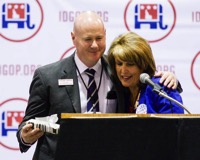
Donald Trump improbably won the Republican presidential nomination by defeating 16 opponents. But he lost in Idaho.
For the Democrats, Hillary Clinton held off Vermont Sen. Bernie Sanders. But not in Idaho.
Republicans worry that their national convention in July will devolve into an angry, fractious spectacle. Democrats hope to link arms in unanimous praise for their standard-bearer, even though Sanders has refused to leave the race officially and endorse Clinton.
The nation might wait with bated breath to see what will happen at July’s national party conventions, but it’s a safe bet they will look different from the ones held here in June. (Democrats concluded theirs Saturday.)
Throughout this presidential election cycle, Idaho, more or less as usual, has marched to the beat of its own drum, on both sides of the political aisle.
What does that mean for Democrats and Republicans in the Gem State? How do they differ from their national ranks? What do national races portend for Idaho races in November? And where is Idaho as a state trending politically?
Both Idaho parties are evolving, generationally and demographically, but don’t expect the national race to influence local races much, or for the political scales, heavily weighted to Republicans, to shift.
Via the Idaho Statesman